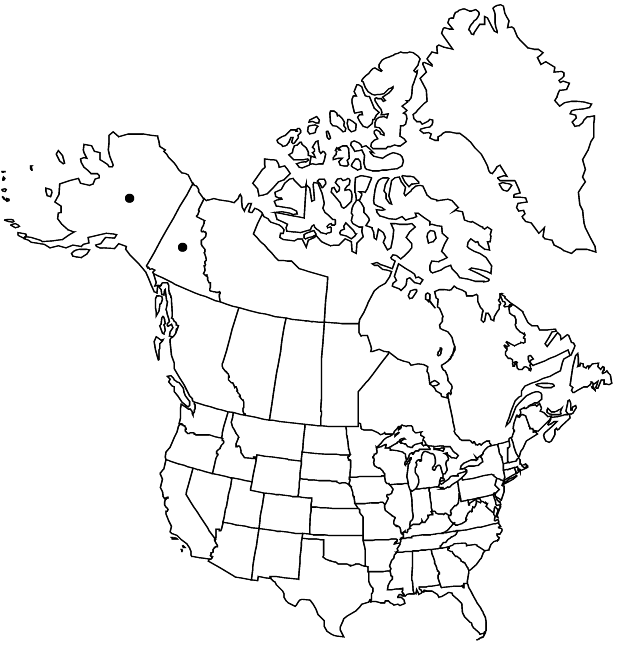Difference between revisions of "Douglasia alaskana"
Canad. J. Bot. 70: 595. 1992,.
FNA>Volume Importer |
imported>Volume Importer |
||
| (6 intermediate revisions by 2 users not shown) | |||
| Line 6: | Line 6: | ||
|place=70: 595. 1992, | |place=70: 595. 1992, | ||
}} | }} | ||
| − | |basionyms={{Treatment/ID/ | + | |special_status={{Treatment/ID/Special_status |
| + | |code=E | ||
| + | |label=Endemic | ||
| + | }} | ||
| + | |basionyms={{Treatment/ID/Basionym | ||
|name=Androsace alaskana | |name=Androsace alaskana | ||
|authority=Coville & Standley ex Hultén | |authority=Coville & Standley ex Hultén | ||
| + | |rank=species | ||
| + | |publication_title=Fl. Alaska Yukon | ||
| + | |publication_place=8: 1279. 1948 | ||
}} | }} | ||
|synonyms={{Treatment/ID/Synonym | |synonyms={{Treatment/ID/Synonym | ||
|name=Androsace alaskana var. reediae | |name=Androsace alaskana var. reediae | ||
|authority=S. L. Welsh & Goodrich | |authority=S. L. Welsh & Goodrich | ||
| + | |rank=variety | ||
}} | }} | ||
|hierarchy=Primulaceae;Douglasia;Douglasia alaskana | |hierarchy=Primulaceae;Douglasia;Douglasia alaskana | ||
| Line 28: | Line 36: | ||
|elevation=0-2000 m | |elevation=0-2000 m | ||
|distribution=Yukon;Alaska. | |distribution=Yukon;Alaska. | ||
| − | |discussion=<p>The single rosettes of Douglasia alaskana are not characteristic of any other species of the genus; they are common in Androsace sect. Aretia, where annual/biennial growth habit appears to have evolved multiple times. Chromosome number, pubescence, and seed anatomy (A. A. Anderberg and S. Kelso 1996) link this taxon to other species of Douglasia. Plants described as var. reediae differ only in the marginally thinner scapes and less noticeably toothed leaves. Because this variation is well within that shown by the species throughout its range in western and southern Alaska, the variety is not recognized here. Douglasia alaskana is widespread but somewhat uncommon in the mountains of southern Alaska and southern Yukon; disjunct populations occur in western Alaska on the Seward Peninsula. Presence in British Columbia was suggested by a misidentified specimen (Carney s.n., 13 Jun 1976, V) from Atlin Lake; D. alaskana is not yet known from that province.</p> | + | |discussion=<p>The single rosettes of <i>Douglasia alaskana</i> are not characteristic of any other species of the genus; they are common in <i>Androsace</i> sect. Aretia, where annual/biennial growth habit appears to have evolved multiple times. Chromosome number, pubescence, and seed anatomy (A. A. Anderberg and S. Kelso 1996) link this taxon to other species of <i>Douglasia</i>. Plants described as var. reediae differ only in the marginally thinner scapes and less noticeably toothed leaves. Because this variation is well within that shown by the species throughout its range in western and southern Alaska, the variety is not recognized here. <i>Douglasia alaskana</i> is widespread but somewhat uncommon in the mountains of southern Alaska and southern Yukon; disjunct populations occur in western Alaska on the Seward Peninsula. Presence in British Columbia was suggested by a misidentified specimen (Carney s.n., 13 Jun 1976, V) from Atlin Lake; <i>D. alaskana</i> is not yet known from that province.</p> |
|tables= | |tables= | ||
|references= | |references= | ||
| Line 37: | Line 45: | ||
-->{{#Taxon: | -->{{#Taxon: | ||
name=Douglasia alaskana | name=Douglasia alaskana | ||
| − | |||
|authority=(Coville & Standley ex Hultén) S. Kelso | |authority=(Coville & Standley ex Hultén) S. Kelso | ||
|rank=species | |rank=species | ||
| Line 51: | Line 58: | ||
|publication title=Canad. J. Bot. | |publication title=Canad. J. Bot. | ||
|publication year= | |publication year= | ||
| − | |special status= | + | |special status=Endemic |
| − | |source xml=https:// | + | |source xml=https://bitbucket.org/aafc-mbb/fna-data-curation/src/2e0870ddd59836b60bcf96646a41e87ea5a5943a/coarse_grained_fna_xml/V8/V8_539.xml |
|genus=Douglasia | |genus=Douglasia | ||
|species=Douglasia alaskana | |species=Douglasia alaskana | ||
Latest revision as of 22:44, 5 November 2020
Plants biennial, not mat- or cushion-forming. Stems ascending, without marcescent leaves. Leaves in single rosette, horizontal, thin; blade cuneate to oblong, 5–15 × 3–8 mm, margins entire, shortly ciliolate, hairs simple, apex acute or remotely 3-toothed, ciliate, hairs simple, abaxial surface densely villous, hairs simple, adaxial surface glabrous or sparsely villous. Scapes to 10 mm in early anthesis, elongating to 1–10 cm in fruit, densely hairy at apex, hairs branched and stellate. Inflorescences 1–2-flowered, usually bracteate, sometimes ebracteate; bracts 1–5, lanceolate, 3–5 × 3–5 mm, glabrous. Pedicels absent. Flowers: calyx 3–6 × 3–4 mm, glabrous; corolla deep purple, white in age, limb 3–5 mm diam., lobes 1–3 × 1 mm, margins entire. 2n = 38.
Phenology: Flowering early summer.
Habitat: Stony places on tundra, alpine scree
Elevation: 0-2000 m
Discussion
The single rosettes of Douglasia alaskana are not characteristic of any other species of the genus; they are common in Androsace sect. Aretia, where annual/biennial growth habit appears to have evolved multiple times. Chromosome number, pubescence, and seed anatomy (A. A. Anderberg and S. Kelso 1996) link this taxon to other species of Douglasia. Plants described as var. reediae differ only in the marginally thinner scapes and less noticeably toothed leaves. Because this variation is well within that shown by the species throughout its range in western and southern Alaska, the variety is not recognized here. Douglasia alaskana is widespread but somewhat uncommon in the mountains of southern Alaska and southern Yukon; disjunct populations occur in western Alaska on the Seward Peninsula. Presence in British Columbia was suggested by a misidentified specimen (Carney s.n., 13 Jun 1976, V) from Atlin Lake; D. alaskana is not yet known from that province.
Selected References
None.
